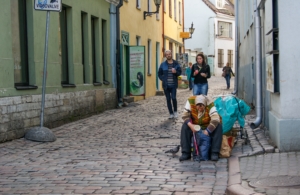Poverty and PTSD
 Commonly associated with combat veterans, Post-traumatic stress disorder (PTSD) impacts more of the global population than maybe expected. Recent studies have found a link between poverty and PTSD that reveals that socioeconomic status contributes to the majority of anxiety disorders.
Commonly associated with combat veterans, Post-traumatic stress disorder (PTSD) impacts more of the global population than maybe expected. Recent studies have found a link between poverty and PTSD that reveals that socioeconomic status contributes to the majority of anxiety disorders.
How Poverty Contributes to PTSD
Mental disorders manifest in distinct ways for many people. However, the common underlying origin of Post-traumatic stress syndrome (PTSD) remains a terrifying or traumatic life event. Living in poverty often means surviving daily in vulnerable conditions, and with financial instability that limits access to necessities such as food, shelter and water. The inability to pay for expenses starts to become emotionally and mentally taxing. Poverty acts as a traumatic experience in many people’s lives and even after graduating in class status, difficulty persists to enjoy day to day life.
Symptoms of PTSD can appear within months of the traumatic event and include:
- Avoiding: Detaching from the traumatic event by avoiding triggers such as places, situations or people.
- Reliving: Flashbacks and nightmares due to memories that force reliving the traumatic experience.
- Increased Arousal: An increased blood pressure or heart rate accompanied by outbursts of anger and difficulties sleeping
Some people with PTSD may exhibit all these symptoms, while others exhibit just a few. The severity of PTSD also varies from person to person. PTSD can be broken down into subtypes such as:
- Delayed on-set PTSD: This variation refers to when symptoms of the disorder develop many years after the traumatic event.
- Complex PTSD: This type of PTSD usually surfaces after ongoing childhood physical or sexual abuse.
- Birth Trauma: This type occurs after traumatic childbirth.
Women with PTSD
Research estimates that 284 million people globally suffer from anxiety disorders such as PTSD. About 63 percent of people that suffer from anxiety disorders are women. In addition, women living in poverty tend to face PTSD at higher levels than any other group within the general population. The relationship between poverty and PTSD embodies that of the domino effect. Poor women’s PTSD symptoms often worsen due to the fact that living in impoverished neighborhoods risk ongoing exposure to triggers of the traumatic incident. A study undertaken by the Social Cognitive Theory also reveals that most of the women living in poverty with PTSD share a history of domestic violence and lack social support.
Treatments
It can feel nearly impossible to live a normal life with PTSD. Luckily, effective treatments exist that minimize the symptoms of the disorder. One of the best treatments for PTSD is Psychotherapy. Psychotherapy allows PTSD victims to talk about their cognitive behavioral process to a mental health professional to reduce and change reactions to triggers. Another important tool for managing PTSD is having a strong support system. The help of friends and family means everything during a mental health crisis. A support system of others that have suffered from PTSD also helps signify that a person is not alone in the experiences of the mental disorder. There are also organizations such as the PTSD Alliance, who work to educate and empower people with PTSD psychologically, economically and emotionally to thrive beyond environmental barriers. The organization currently has five international partners that provide programs to help improve the lives of those living in poverty with PTSD.
Overall, poverty and PTSD remain two prominent issues impacting people on a global scale. The connection between poverty and PTSD only further emphasizes that the more work that is done to reduce global poverty also diminishes the mental health crisis.
– Nia Coleman
Photo: Wikimedia
